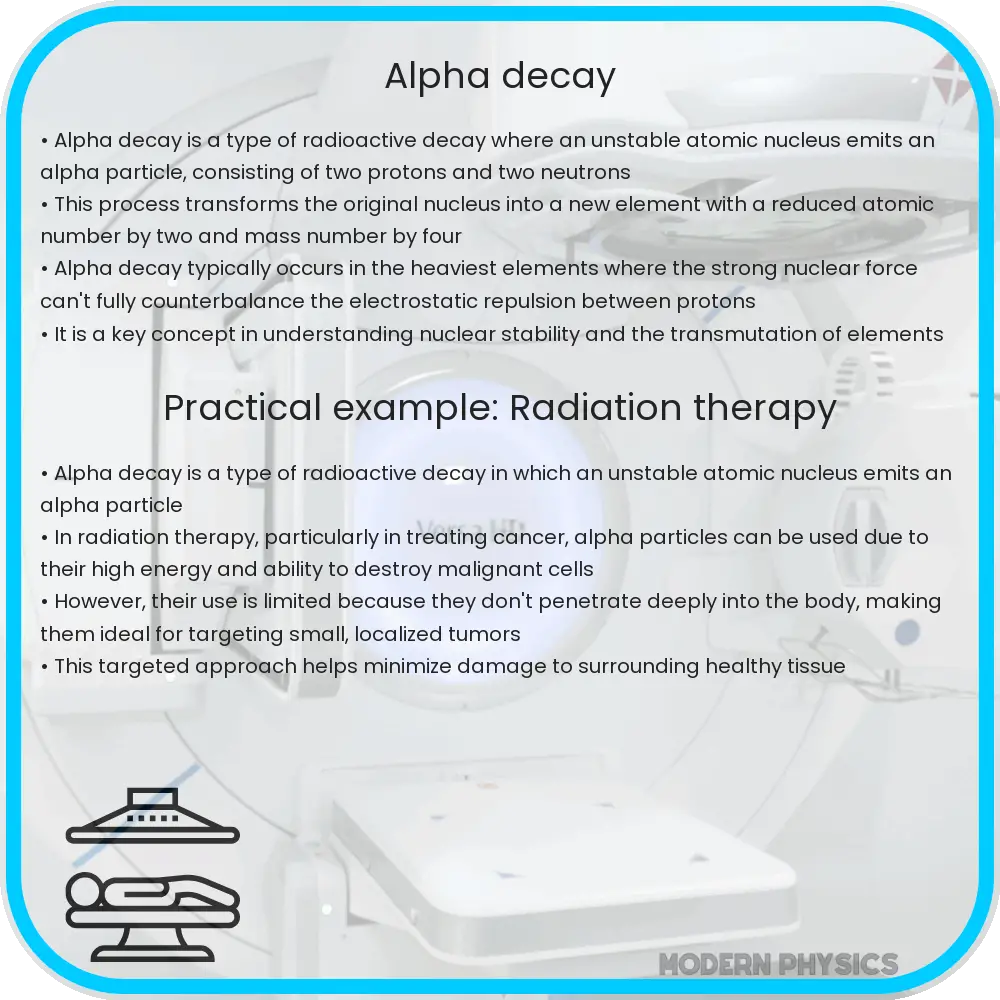Learn about alpha decay, a radioactive process where a nucleus emits an alpha particle, leading to a new, lighter nucleus.

Overview of Alpha Decay
Alpha decay is a type of radioactive decay in which an atomic nucleus emits an alpha particle and transforms into a new nucleus. An alpha particle consists of two protons and two neutrons, which is the same as a helium-4 nucleus. This process decreases the mass number of the original nucleus by four and the atomic number by two, leading to a significant transformation in the atomic structure.
The Process of Alpha Decay
Alpha decay typically occurs in the heavier elements found in the periodic table, such as uranium and radium. The process can be understood in a series of steps:
- Nucleus Instability: The decay begins when a nucleus becomes unstable due, in part, to an imbalance between the number of protons and neutrons. This instability makes the nucleus seek a more stable configuration.
- Formation of Alpha Particle: Within the unstable nucleus, two protons and two neutrons come together to form an alpha particle.
- Emission of Alpha Particle: Once the alpha particle is formed, it is emitted from the nucleus. The emission of the alpha particle is due to quantum tunneling, where the particle escapes through the potential barrier of nuclear forces despite not having enough energy to overcome it under classical mechanics.
- Resultant Nucleus: After the emission of the alpha particle, the leftover nucleus has an atomic number reduced by two and a mass number reduced by four. This newly formed nucleus is often in an excited state and may release energy by emitting gamma rays to reach its ground state.
The equation representing alpha decay can be generally expressed as:
^A_ZX → ^{A-4}_{Z-2}Y + ^4_2He,
where ^A_ZX is the original unstable nucleus, ^{A-4}_{Z-2}Y is the new nucleus formed, and ^4_2He represents the alpha particle.
Examples of Alpha Decay
Alpha decay is commonly observed among the heavier elements with atomic numbers greater than 82. Some notable examples include:
- Uranium-238 Decay: One of the most well-known examples of alpha decay is the decay of uranium-238. It decays through alpha emission to form thorium-234 according to the equation:
^{238}_92U → ^{234}_{90}Th + ^4_2He - Radium-226 Decay: Another example of alpha decay is radium-226 decaying to radon-222. This is described by the equation:
^{226}_88Ra → ^{222}_{86}Rn + ^4_2He
These transformations through alpha decay illustrate an important mode of spontaneous nuclear change, profoundly influencing the nature and stability of atoms.
Applications of Alpha Decay
Alpha decay is not just a theoretical concept; it has practical applications in various fields. Some of the main applications include:
- Smoke Detectors: Alpha particles emitted during alpha decay can ionize air particles, making them conductive. In smoke detectors, americium-241, an alpha emitter, is used to ionize air in a small ionization chamber. Smoke entering the chamber reduces ionization and triggers the alarm.
- Radiometric Dating: Alpha decay plays a crucial role in radiometric dating methods, like uranium-lead dating, which helps geologists determine the age of rocks and other geological features.
- Medical Applications: The use of alpha-emitting isotopes in targeted cancer therapy has shown promise. For example, isotopes like bismuth-213 are attached to antibodies that specifically target cancer cells. This allows the alpha particles to kill cancer cells while minimizing harm to surrounding healthy tissues.
Safety Considerations with Alpha Emitters
While alpha particles cannot penetrate human skin, they can be hazardous if alpha-emitting materials are inhaled, ingested, or enter the body through wounds. Therefore, strict safety protocols are necessary when handling materials that undergo alpha decay, particularly in medical and industrial settings. Adequate shielding, proper ventilation, and rigorous hygiene practices are crucial to minimize risks associated with alpha emitters.
Conclusion
Alpha decay is a fascinating and complex process that plays a significant role in the fields of physics, geology, and medicine. By understanding this radioactive decay mechanism, scientists and engineers can harness its potential in various applications, from environmental monitoring to cancer treatment. Despite its beneficial uses, the handling of alpha-emitting materials requires careful consideration of health and safety aspects to avoid risks. Through ongoing research and technological advancement, the applications of alpha decay continue to expand, offering new solutions to longstanding challenges.
